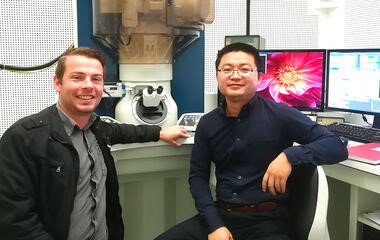A first for South Africa and Africa, and right up there with the best in the world, is our ability to not only research the tiniest components in materials to the atomic level, but to study how the micro structure of materials changes, live and in real time, when material components are subjected to stimuli, such as heating.
This is what our team of scientists and students can now do, using the new, in situ microscope specimen holders and electron detector technology (the DENS solutions wildfire holder and the Merlin for EM Hybrid Pixel Detector), installed at the Centre for High Resolution Transmission Electron Microscopy (CHRTEM), department of physics, Nelson Mandela University (NMU) [in Port Elizabeth, South Africa].
It exponentially speeds up the research process from a few weeks or months to a few hours or one week at the most, depending on what we are investigating.
We are currently ramping up to full utilisation of the new system and we’ve also acquired big data computing hardware to be able to process the immense amount of data the new system generates. We are able to work at the same level as the leading laboratories internationally as this is one of the world’s best direct electron detectors.
I worked with electron detector technology in the United Kingdom and Germany where it has been available for a few years, and I have been motivating for South Africa to invest in it as there is a huge demand locally and internationally for this research.

Dr Jaco Olivier testing out the new detector system in Stuttgart, Germany, with research associate Dr Yi Wang, Image provided
Fast-tracking research
It was purchased in partnership with the National Research Foundation’s National Equipment Programme (NEP).
The NEP contributed two-thirds of the more than ZAR6.6 million (about US$406,418) cost of the system, while NMU contributed the remaining third. As a national facility, the CHRTEM provides consultation and expert support in electron microscopy to scientists, collaborative scientific projects and industry, locally and internationally.
The pandemic delayed its arrival, but it is finally here and there is huge excitement at the CHRTEM about the research breakthroughs we will be able to achieve with it.
We have some excellent masters and PhD students working on this already, but the next challenge is finding more students to tackle the many projects we want to do.
My team recently used the electron detector to study aluminium for an industry collaborator.
We looked at what happens to aluminium at a microscopic level when it undergoes a specific heating treatment. Heating affects the properties of the material, its strength and durability, and it offers industry almost instant results that inform the changes they need to make to optimise the manufacturing process.
What now takes us an hour or two to get our results would previously have taken two weeks to four months.
In the past, we had to generate data from different specimens, sampled from the material at different stages of the heating process. Thereafter, we had to reconcile what we were observing in the images obtained from different specimens, whereas now we can do this directly from one specimen in a correlated way with high accuracy and greatly improved sensitivity.
We can also use the new system to research the behaviour of nuclear materials at high temperatures in order to improve the safety and efficiency of the plant for electricity generation.
Hydrogen as renewable energy
Another piece of equipment we have enables us to see how materials interact with a gas at different temperatures.
So, for example, we can interact materials at high temperatures in an oxygen or hydrogen environment to assess corrosion or catalyst activation and study this in an accelerated way. For the chemicals industry, we can now prototype adjustments made to catalyst materials by subjecting it to simulated reactor environments.
Our team is already generating a range of results for industry and we are also part of a recently established NMU hydrogen research group that is developing research opportunities related to the [South African] Department of Science and Innovation’s Hydrogen Society Roadmap framework.
Hydrogen is a promising renewable source of energy that would, at the same time, help South Africa to reduce its carbon emissions.
Dr Jaco Olivier is the chief scientist and electron microscopist at the Centre for High Resolution Transmission Electron Microscopy, Nelson Mandela University, South Africa. Olivier supervises postgraduate students at NMU and provides national and international support to all research centres using the facility.
This article was published on University World News on 19 May 2022 https://www.universityworldnews.com/post.php?story=20220517035005715